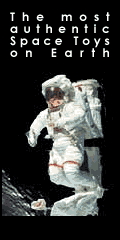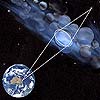
|

|

|

|
YESTERDAY'S SPACE
SPACEWAR TERRADAILY SPACEMART TECH SPACE DRAGON SPACE SPACE TRAVEL ROCKET SCIENCE MARSDAILY SPACE DATABASE EMAIL US /ABOUT US AD RATES 
|
The European Space Agency's star-crossed "Rosetta" comet mission -- whose launch has now been delayed for a year by the problems with its Ariane 5 launcher -- has dodged another bullet, with a critical defueling operation set to go ahead in May. With launch slated for next February on a regular Ariane 5. Rosetta will take a decade to reach the final target object for rendezvous - Comet Churyumov-Gerasimenko. |
|
|
|
 Carbon NanoTubes Could Wire Tomorrow's Chips
Carbon NanoTubes Could Wire Tomorrow's ChipsMoffett Field - Apr 15, 2003 The life of the silicon chip industry may last 10 or more years longer, thanks to a new manufacturing process developed by NASA scientists. The novel method, announced in the April 14 issue of the journal Applied Physics Letters, includes use of extremely tiny carbon 'nanotubes' instead of copper conductors to interconnect parts within integrated circuits. Tiny Bubbles Are Key To Liquid-Cooled System For Future Computers  West Lafayette - Apr 15, 2003
West Lafayette - Apr 15, 2003Purdue University researchers have made a discovery that may lead to the development of an innovative liquid-cooling system for future computer chips, which are expected to generate four times more heat than today's chips. Industry Gathers For ESA/EC Global Monitoring Programme  Paris (ESA) Apr 14, 2003
Paris (ESA) Apr 14, 2003Representatives from 10 industry consortia met recently to plan the next phase of ESA's contribution to the Global Monitoring for Environment and Security programme. |
Columbia's Secrets Are Reel Enough Sacramento - Apr 16, 2003
Superlubricant Effect Explained Using New Friction Force Sensor  Den Haag - Apr 15, 2003
Den Haag - Apr 15, 2003Research conducted in the Netherlands has revealed a previously unknown effect in graphite. The discovery was made by Martin Dienwiebel using the Tribolever, a highly-sensitive friction force microscope which he had developed himself. Dienwiebel has termed the effect superlubrication and this effect probably explains why graphite is such a good lubricant. |
Gallium Nitride Yields Optically Active Nanotubes Berkeley - Apr 15, 2003
Berkeley - Apr 15, 2003Nanowires and carbon nanotubes, each with their pluses and minuses, are advertised as the next-generation building blocks for electronic circuits a thousand times smaller than today's semiconductor circuits. Gas Clouds Make New "Telescope"  Canberra - Apr 11, 2003
Canberra - Apr 11, 2003Astronomers have found a way to harness clouds of gas in space to make a natural 'telescope' more powerful than any manmade telescope currently in operation. |
Proliferation And The Nuclear Space Age Brisbane - Apr 14, 2003
Brisbane - Apr 14, 2003Now the nuclear club is growing towards double figures although many of its new members aren't "officially" recognised. Many nations leaders are unhappy about the way some other countries have the bomb and they don't. Even those in as close proximity to the US as Mexico have expressed grievances over this issue. It is believed that more than a couple of countries are taking matters into their own hands by developing nuclear weapons arsenals secretly. |
|
|
|
|
|
|
|
| The contents herein, unless otherwise known to be public domain, are Copyright 1995-2003 - SpaceDaily. AFP Wire Stories are copyright Agence France-Presse ESA Portal Reports are copyright European Space Agency. Additional copyrights may apply in whole or part to other bona fide parties. Advertising does not imply endorsement, agreement or approval of any opinions, statements or information provided by SpaceDaily on any web page published or hosted by SpaceDaily. Privacy Statement |